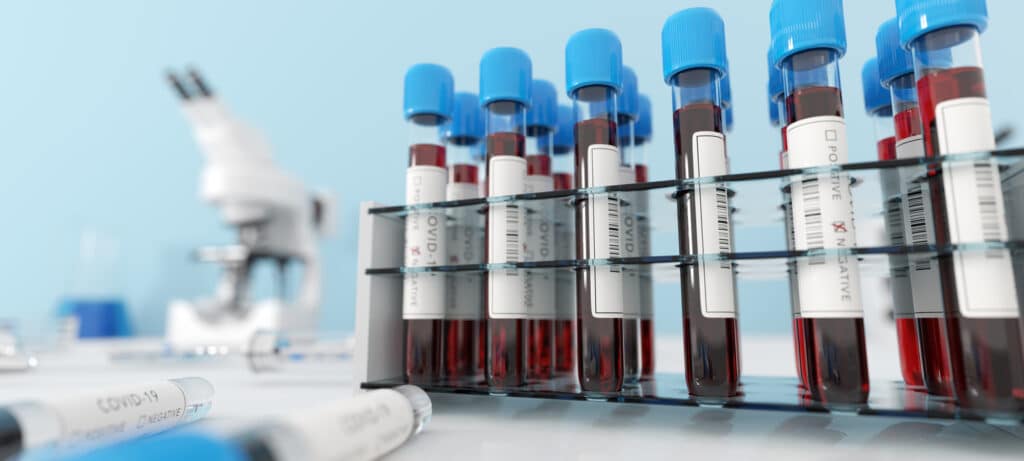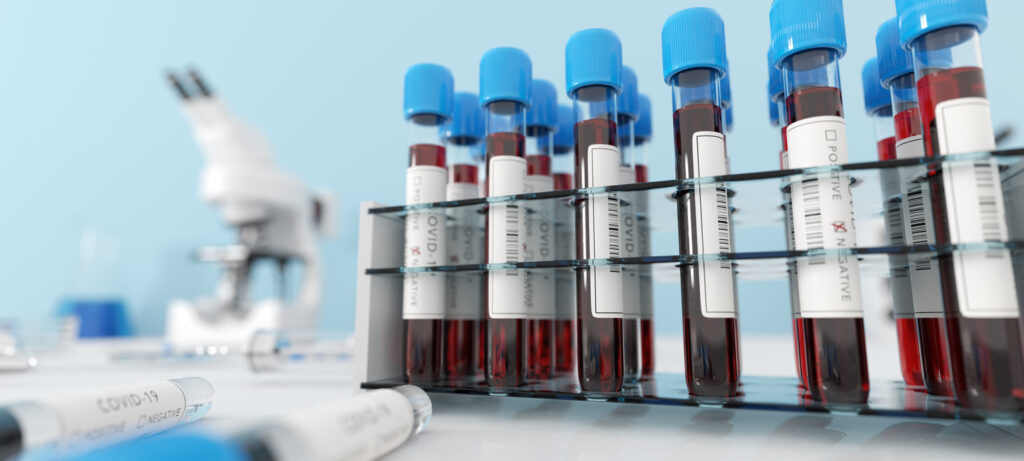Your cart is currently empty!
Concerned about Toxoplasma gondii exposure? This guide goes over the toxoplasma gondii parasite test, deciphering test results, and explaining their potential implications for your health—with an eye on what it means for expectant mothers. Understand what a positive or negative result could indicate, and how to proceed, without wading through medical jargon.
Key Takeaways
The Toxoplasma gondii test detects antibodies to determine if there’s a current or past infection, with IgM suggesting recent infection and IgG indicating past exposure.
Pregnant women should get tested for Toxoplasma gondii to avoid transmitting the infection to the fetus; immediate therapy with spiramycin is recommended if there’s a suspected acute infection.
Treatment varies based on patient condition, with healthy individuals often not requiring it, while pregnant women, newborns, and immunocompromised patients might need medication.

Toxoplasma Gondii Test is a Blood Serology Test
The Toxoplasma gondii test, commonly known as the toxoplasmosis test, is a blood test designed to detect the presence of Toxoplasma gondii antibody, indicating a current or past infection. The test starts with a blood draw, like the cbc blood test, but instead it uses serological methods…including the Sabin-Feldman dye test, indirect fluorescent antibody (IFA) test, and enzyme immunoassay (EIA), which all may contribute to the diagnosis of toxoplasmosis.
Identifying antibodies is vital because it aids in ascertaining the existence and timeline of the infection. Now you might be thinking, what do these antibodies mean? There are two main types that we focus on: IgM and IgG antibodies. IgM antibodies usually appear soon after infection and suggest a recent or acute infection. On the other hand, the presence of IgG antibodies without IgM indicates a past or latent infection.
The Significance of Testing During Pregnancy

Pregnancy can be an exciting time, filled with joy and anticipation. However, it also brings a unique set of challenges, one of which is the risk of contracting infections like toxoplasmosis. This is why it’s paramount to conduct a toxoplasmosis test during pregnancy. It helps prevent transmission of the infection to the fetus and avoid serious complications that can arise from an active infection.
Not all pregnant women are routinely tested for Toxoplasma gondii. Testing is usually conducted when there is exposure to risk factors or when the healthcare practitioner suspects an infection. Blood tests checking for antibodies are used to diagnose toxoplasmosis in pregnancy. These tests indicate whether there has been a recent infection and assess the risk to the baby.
In case of a recent infection, further testing may be undertaken at a reference lab, with possible additional assessments like amniocentesis to determine if an infection occurred in the fetus. Significantly, PCR technology has transformed prenatal diagnosis by enabling quick and precise detection of Toxoplasma in expectant mothers.
If a suspected acute infection is detected, immediate therapy with spiramycin is initiated to prevent fetal infection, even before confirmatory test results. So, if you’re pregnant and your doctor recommends a toxoplasmosis test, it’s not because they want to add another item to your to-do list, but because they want to ensure the health and well-being of both you and your baby…and to avoid potentially serious birth defects.
Sample Collection: What to Expect

Just like any other medical test, the Toxoplasma gondii test starts with sample collection. Blood is the most common type of sample collected for toxoplasmosis testing. But did you know that amniotic fluid and cerebrospinal fluid can also be used?
The collection of these samples involves specific procedures. Amniotic fluid is typically collected via amniocentesis, which involves a guided needle insertion through the abdomen under ultrasound, using local anesthesia. Cerebrospinal fluid, on the other hand, is obtained through a lumbar puncture with the patient positioned accordingly. This procedure requires rest afterwards to prevent headaches.
While these procedures may sound intimidating, they are routine and are performed by trained professionals to ensure minimal discomfort.
Unpacking Test Results
Once the sample is collected and sent to the laboratory, the next step is understanding the test results. High titers, which indicate a recent infection or an active immune response, and the avidity test, which measures the binding force of antibodies to antigens, can help differentiate between acute and chronic Toxoplasma infection.
Generally, after infection with Toxoplasma gondii, antibodies reach their highest levels 1 or 2 months after infection, which can be critical for timing the onset of acute infection. What implications do high or low antibody levels carry? We will explore this further in the upcoming sections.
Interpreting IgG and IgM Antibodies
You might be wondering what these IgG and IgM antibodies are and why they are so important in understanding the results of a Toxoplasma gondii test. Well, these antibodies are like the body’s detectives. They are produced by the immune system in response to an infection and can give us clues about when the infection happened.
IgG antibodies indicate past exposure to T. gondii. They are usually detected several weeks after the initial infection and remain in the body for life. On the other hand, IgM antibodies are the body’s immediate response to an infection. They are produced within the first few weeks and can remain detectable for up to 2 years, suggesting a more recent infection.
The presence of IgG antibodies without IgM typically suggests a past infection. If both IgG and IgM antibodies are present, it may indicate a recent or acute infection. By understanding these antibodies, you’ll be able to paint a clearer picture of your toxoplasmosis infection and its timeline.
Understanding Titers and Avidity Tests
Another important piece of the puzzle in understanding your test results is interpreting titers and avidity tests. Titers are the measurement of the concentration of antibodies in the blood and help gauge the strength of the immune response against an infection.
In contrast, IgG avidity tests measure the strength of binding between IgG antibodies and antigens to differentiate recent from past infections. Low-avidity IgG antibodies indicate a recent infection, while high-avidity antibodies suggest past exposure to the pathogen.
The Relative Avidity Index (RAI) evaluates IgG antibody avidity, categorizing it as low, equivocal, or high, each reflecting different infection timelines. In fact, a study demonstrated that a significant proportion of pregnant women with positive IgM also had low IgG avidity, pointing to acute toxoplasma infections.
Risks and Preparation for the Toxoplasma Test
Having grasped the essence of the test and its results interpretation, it’s time to discuss its potential risks and necessary preparation. The good news is that when a blood sample is taken for the toxoplasma gondii test, there is very little chance of complications, though a small bruise may form at the site. Moreover, no specific preparation is generally needed before taking a toxoplasma gondii test.
However, it’s important to inform your healthcare provider of any immune system conditions and medications that could affect the immune response prior to taking the test. Immunocompromised patients in areas where T. gondii is endemic are recommended to have routine serological screening for the infection due to a higher risk of reactivation of latent infection.
Treatment Options After Diagnosis
What happens after a toxoplasmosis diagnosis? The treatment options vary depending on the patient’s health, pregnancy status, and severity of infection. Most healthy individuals recover from toxoplasmosis without treatment. But treatment with drugs such as pyrimethamine, sulfadiazine, and folinic acid may help those who are ill.
While treatment can reduce the severity of toxoplasmosis, it does not reverse damage that has already been done. In cases where a pregnant woman is infected with toxoplasmosis but the fetus is not yet known to be infected, spiramycin is offered for fetal prophylaxis.
When fetal toxoplasmosis infection is confirmed or highly suspected, treatment should include a combination of pyrimethamine, sulfadiazine, and folinic acid. However, treatment in pregnant women, newborns, and infants does not completely eliminate the parasite, which can remain within tissue cells in a less active phase.
For immunocompromised individuals who may experience severe complications from Toxoplasma gondii infection, ongoing treatment may be required for as long as they are immunosuppressed, to prevent a chronic infection.
Preventative Measures Against Toxoplasma Infection
Once you comprehend the test results and potential treatment pathways, the focal point shifts to prevention. After all, prevention is better than cure. So how can we prevent Toxoplasma infection? One of the most effective ways is through proper food handling.
For instance, to ensure food safety and avoid undercooked or raw meat:
Meat should be cooked to safe internal temperatures to kill any parasites.
Freezing meat at sub-zero temperatures for several days may greatly reduce the chance of Toxoplasma gondii infection.
Always rinse fresh fruits and vegetables under running water prior to consumption.
Preventing cross-contamination in the kitchen is also crucial. Make sure to wash utensils, cutting boards, and countertops with hot, soapy water after use with different food items. Lastly, avoiding consumption of raw or undercooked oysters, mussels, or clams, and drinking unpasteurized goat’s milk can prevent Toxoplasma gondii infection.
Laboratory Tests and Diagnostic Methods

Next, we will delve into the laboratory tests and diagnostic methods employed for Toxoplasma gondii infection. One of the main methods is Polymerase chain reaction (PCR), a molecular testing method used to detect T. gondii DNA in blood, amniotic fluid, or other tissues. PCR testing provides high sensitivity, even detecting a single tachyzoite, and does not require live parasites for a positive result. On the other hand, the enzyme-linked immunosorbent assay (ELISA) is utilized for its economy and reliability in detecting antibodies against T. gondii.
It’s important to note that ELISA test performance varies with antigen types and antibody reagents, with recombinant or chimeric antigens showing improved sensitivity and specificity. By understanding these diagnostic methods, you’ll be better equipped to navigate the journey of a toxoplasmosis diagnosis.
The Role of the Immune System in Toxoplasmosis
Our immune system serves a pivotal function in combating Toxoplasma gondii infection. The first line of defense involves innate immunity, which includes the detection of the pathogen through pattern recognition receptors like Toll-like receptors and Nod-like receptors, and the production of critical proinflammatory cytokines by innate immune cells.
After the initial response, the adaptive immune system targets T. gondii through the production of interferon-gamma by natural killer cells, CD4+ T cells, and cytotoxic CD8+ T cells. However, T. gondii is a wily invader. It can evade the host immune response by secreting factors that inhibit both acquired and innate defenses, enhancing its survival and proliferation in the host.
To prevent an excessive inflammatory response that could damage the host, regulatory T cells and other immune cells produce interleukin 10 (IL-10) to maintain immune homeostasis during a T. gondii infection, especially in individuals with a weakened immune system.
Furthermore, the immune response to T. gondii also involves autophagy-related genes and immunity-related GTPases like IRGA6 and IRGB6, which disrupt the parasitophorous vacuole membrane the parasite resides in, inhibiting its proliferation.
Navigating Congenital and Acute Toxoplasmosis
Congenital and acute toxoplasmosis present different challenges. Acute toxoplasmosis in immunocompetent adults is usually asymptomatic or presents with mild symptoms like fever, malaise, and tender lymph nodes. On the other hand, congenital toxoplasmosis, a type of congenital infection, can lead to more serious recurring issues such as vision loss and developmental delays.
PCR/DNA T. gonddii testing is instrumental, particularly in instances of congenital toxoplasmosis, thus directing suitable treatment strategies. Long-term effects of congenital toxoplasmosis include a range of complications, with some individuals remaining asymptomatic while others may experience problems primarily before the age of 5, with complications usually occurring before the age of 10.
Complications from T. gondii infection can result in severe eye infections with potential to cause scarring on the retina. Being cognizant of these challenges and seeking advice from healthcare providers for optimal management strategies is of utmost importance.
Summary
In summary, understanding your Toxoplasma gondii blood test is a vital step in managing and preventing toxoplasmosis. From decoding the test and interpreting the results, to understanding the role of the immune system in combating the infection, each piece of knowledge empowers you to take charge of your health. Remember, knowledge is power. By learning about toxoplasmosis, its testing, and treatment options, you’re not only safeguarding your health but also contributing to the larger fight against this common parasite.
Frequently Asked Questions
How do you test for toxoplasmosis parasites?
To test for toxoplasmosis parasites, talk with your doctor about a toxoplasma blood test to look for antibodies in your blood that indicate the presence of the Toxoplasma gondii parasite. This can help diagnose the infection. Other methods like blood smear or stained tissues can find toxoplasmosis, but the fastest and most useful test is typically the blood antibody test.
Can humans and cats be tested for T. gondii?
Yes, both humans and cats can be tested for T. gondii through a blood test that checks for antibodies to the parasite, providing information about the infection and its timing.
Why is testing for toxoplasmosis important during pregnancy?
Testing for toxoplasmosis during pregnancy is crucial because it helps prevent the transmission of the infection to the fetus and avoids potentially serious complications from an active infection. It’s important for the health of the baby.
What do IgG and IgM antibodies indicate?
IgG antibodies indicate past exposure to the infection, while IgM antibodies suggest a more recent infection.
What are the treatment options after a toxoplasmosis diagnosis?
The treatment options for toxoplasmosis depend on factors such as the patient’s health, pregnancy status, and the severity of infection. Most healthy individuals can recover without treatment, but some may need medication.
Article Sources
Laboratory Diagnosis of Toxoplasma gondii Infection and Toxoplasmosis: https://academic.oup.com/jid/article/185/Supplement_1/S73/2908786
Toxoplasmosis (Toxoplasma infection): https://www.cdc.gov/parasites/toxoplasmosis/index.html